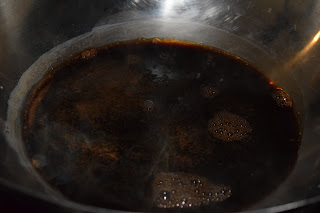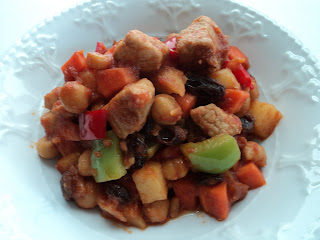Bicol or Bikol (Region V) is composed of the four provinces in the Bicol peninsula namely
Camarines Sur, Camarines Norte, Albay and Sorsogon and two island provinces of Catanduanes and Masbate. Agriculture is a large component of the region's economy.
Bicolano cuisine is distinguished for its use of hot peppers and coconut milk. Laing, Bicol Express and pili nut candies are the most popular specialties in the region. Laing is a creamy vegetable stew made with dried taro leaves, chili peppers and coconut milk.
The name "Bicol Express" was coined in Manila to refer to a fiery Bicolano dish called Sinilihan (with Chili Peppers.) The dish is named after the passenger train that takes people from Manila to Bicol. Bicol Express or Sinilihan is a stew made of siling haba (finger chili peppers), coconut milk, pork, shrimp paste, garlic and onion. First timers would say that there's more peppers than meat in this dish. It is so spicy that it requires a lot of rice on the side. Bicol express is a main entree that can be served for lunch or dinner.
This recipe was made with the suggestions from my friend who is from Bicol. See notes below the recipe to find out about a healthier and tongue-friendly substitutions.
Bicol Express
Prep Time: 25 minutesCooking Time: 50 minutes
Yield: 4 servings
Ingredients:
- 14 ounce coconut milk (or 1 cup freshly squeezed coconut milk ftom grated mature coconut flesh)
- 1 knob ginger, roughly chopped and smashed
- 1/2 pound pork belly, cut into strips
- 6 cloves garlic, minced
- 1/2 medium onion, chopped
- 3 tablespoons uncooked shrimp paste
- 15 pieces siling haba (finger hot peppers), stemmed and cut diagonally
- 4 pieces siling labuyo (Thai chili peppers), finely chopped
- 1/4 kakang gata (cream of coconut)
Procedure:
- Combine coconut milk and ginger in a deep skillet over medium high heat. Bring to a boil.
- Add pork, garlic and onion. Simmer for 15 minutes.
- Add shrimp paste and hot peppers. Continue cooking for another 25 minutes or until the pork is tender.
- Add cream of coconut and simmer for 5 minutes.
- Serve warm with rice.
* Kakang gata or cream of coconut is different from canned coconut cream. The former is extracted from grated flesh of a mature coconut. The canned coconut cream is sweetened with sugar so definitely not use the canned one. If you can't make your own kakang gata, here's a cheater's guide: Pour the coconut milk from a can in a tall cup and chill for 30-45 minutes. It will cause the "creamy" part of the coconut milk to separate from the liquid. Skim the cream out snd leave the watery part at the bottom.
* Gata or coconut milk is produced by adding water to the grated flesh of a mature coconut and extracting the liquid from. The process yields more luquid called coconut "milk."
* Pork belly may be replaced with a lean cut of pork (without fat.)
* Try not to decrease the amount of chili peppers too much because by doing so, the dish won't taste as authentic as the Sinilihan dish. It will taste more like Binagoongang Baboy (Pork in Fermented Shrimp Paste.)

































































